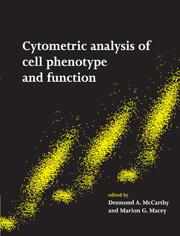Book contents
- Frontmatter
- Contents
- List of contributors
- List of abbreviations
- 1 Principles of flow cytometry
- 2 Introduction to the general principles of sample preparation
- 3 Fluorescence and fluorochromes
- 4 Quality control in flow cytometry
- 5 Data analysis in flow cytometry
- 6 Laser scanning cytometry: application to the immunophenotyping of hematological malignancies
- 7 Leukocyte immunobiology
- 8 Immunophenotypic analysis of leukocytes in disease
- 9 Analysis and isolation of minor cell populations
- 10 Cell cycle, DNA and DNA ploidy analysis
- 11 Cell viability, necrosis and apoptosis
- 12 Phagocyte biology and function
- 13 Intracellular measures of signalling pathways
- 14 Cell–cell interactions
- 15 Nucleic acids
- 16 Microbial infections
- 17 Leucocyte cell surface antigens
- 18 Recent and future developments: conclusions
- Appendix
- Index
- Plate section
14 - Cell–cell interactions
Published online by Cambridge University Press: 06 January 2010
- Frontmatter
- Contents
- List of contributors
- List of abbreviations
- 1 Principles of flow cytometry
- 2 Introduction to the general principles of sample preparation
- 3 Fluorescence and fluorochromes
- 4 Quality control in flow cytometry
- 5 Data analysis in flow cytometry
- 6 Laser scanning cytometry: application to the immunophenotyping of hematological malignancies
- 7 Leukocyte immunobiology
- 8 Immunophenotypic analysis of leukocytes in disease
- 9 Analysis and isolation of minor cell populations
- 10 Cell cycle, DNA and DNA ploidy analysis
- 11 Cell viability, necrosis and apoptosis
- 12 Phagocyte biology and function
- 13 Intracellular measures of signalling pathways
- 14 Cell–cell interactions
- 15 Nucleic acids
- 16 Microbial infections
- 17 Leucocyte cell surface antigens
- 18 Recent and future developments: conclusions
- Appendix
- Index
- Plate section
Summary
Adhesion molecules in cell–cell interactions
Introduction
Cell–cell interactions are a feature and function of all living cells. Examples include interactions of mobile cells such as ova and sperm and the solid coalescence of skin cells to form a watertight epidermis. Cell–cell interactions are of importance both in cell structure and cell function. Cell–cell interactions provide physical barriers (skin), boundaries (organ capsules) and tissue cohesion. They provide a mechanism of communication between cells (nervous tissue) and are the means of reproduction (the cell–cell interaction of ova and sperm). When these interactions occur in mobile cells, for example in the blood, they are the means of switching on, spreading or regulating fundamental processes such as inflammation and coagulation.
Many cell–cell interactions are mediated via cell adhesion molecules (CAMs). CAMs are surface membrane structures designed or adaptable to binding with similar structures, termed ligands, on other cells. Many CAMs have now been identified and their molecular structures have been elucidated. Based on structural homology, to date, six families of CAMs have been defined but there are a number of new adhesion molecules that are yet to be grouped.
The families so far known are the immunoglobulin family, the cadherin family, the integrin family, the selectins, the surface proteoglycan family and the sialomucin family. CAMs play an important role in signal transduction as well as mediating adhesion with other cells and matrix components. Most CAMs may also be found as soluble circulating proteins, and levels of these soluble CAMs have been found to be raised in inflammatory conditions.
Information
- Type
- Chapter
- Information
- Cytometric Analysis of Cell Phenotype and Function , pp. 247 - 270Publisher: Cambridge University PressPrint publication year: 2001
Accessibility standard: Unknown
Why this information is here
This section outlines the accessibility features of this content - including support for screen readers, full keyboard navigation and high-contrast display options. This may not be relevant for you.Accessibility Information
- 1
- Cited by
